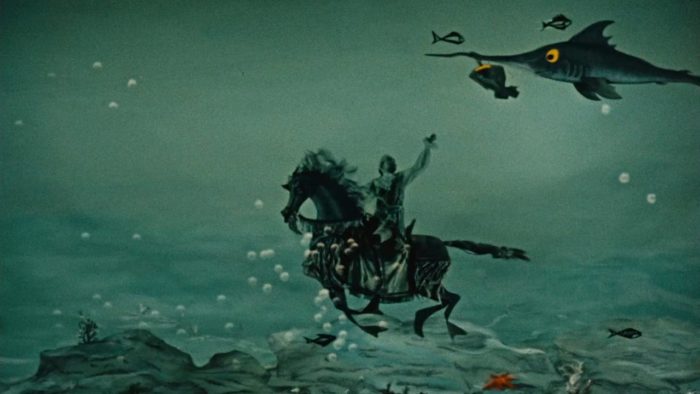
The Fabulous Baron Munchausen might be the movie I chose to review for Criterion Month this year that I had the least knowledge of and the least context for. Which might be the best way to go into this movie, considering it truly feels like nothing else. I know that may sound like hyperbole, especially considering I’ve watched far too many movies to ever be truly taken off guard by what kind of images are capable of being brought to the screen. But Czech filmmaker Karel Zeman was clearly a one-of-a-kind visual stylist, even if he may not have the same recognition as many of the other pre-CG visual effects pioneers.
In addition to my lack of context for Karel Zemen and Czech filmmaking as a whole, I also had little context for who Baron Munchausen is as a character. Apparently, Munchausen first appeared in German writer Rudolph Eric Raspe’s Baron Munchausen’s Narrative of his Marvellous Travels and Campaigns in Russia, and has since made numerous appearances in various literature and film since his introduction in 1785. From reading just a bit about the Baron’s most famous adventures, it makes this film seem a little less insane, since apparently Munchausen’s stories always had a very fantastical, tall-tale bent to them.
The first of these tall tales (that is apparently canon) is that Baron Munchausen traveled to the moon, which is where this movie starts. While on the moon, Munchausen (played by Miloš Kopecký) encounters a moonman (basically a proto-astronaut sporting a rounded, tubular suit) named Tonik (Rudolf Jelínek) who Munchausen convinces to come back to Earth with him. It’s not ever really specified whether Tonik is from the future or an alien or what, but this movie is never terribly concerned with plot or character details, and that’s fine.
After flying from the moon back to Earth upon his ship guided by winged horses, the Baron introduces the Tonik to the Sultan of Constantinople. The Sultan isn’t terribly impressed by the Tonik, who quickly becomes more enamored with Princess Bianca, who is seen lingering around the castle. After Tonik and Bianca fall for each other, this leads to the Baron getting into a fight with the castle guards and he then kills literally all of them. I guess because he’s just that good of a swordsman. This becomes the first of many swashbuckling adventures that the Baron, Tonik, and Bianca go on, which includes several naval battles, being swallowed by a sea monster, and once again flying through space.
Talking about plot in regards to this movie is probably beside the point, because its merits are indebted almost entirely to its astounding visuals. Honestly, there are so many remarkable things about the look of this movie that it’s hard to even know where to start. I suppose the first place would be with the way the movie uses color. It seems that Baron Munchausen was shot almost entirely in black and white, while each setting of the film is tinted to a different color, much like the more fantastical silent films that were hand-painted for a similar effect. This is just one of the many aspects of the film where early silent film fantasist George Méliès (who made his own Munchausen film in 1911) seems like a clear influence.
The other most prominent part of the film’s indebtedness to Méliès is how the film uses a combination of two-dimensional and three-dimensional images throughout the film. Some of this is through hand-drawn backgrounds, some of it is through animation, and some of it seems to be in the set design which uses these artificial-looking backdrops. It makes for a world that never feels even remotely real, and yet the endless playfulness of the visuals and the attention to detail still makes it feel like a fully-realized world. Even if it feels like a world out of a painting or a children’s picture book, rather than the type of world we’re used to seeing on film.
Though Karel Zeman was a filmmaker that I wasn’t familiar with until after some of his films were released in a box set by Criterion a couple years ago, I was glad to see he has some famous fans. In addition to Méliès, he’s often been compared to Ray Harryhausen, who mentioned his admiration for Zeman, as have more modern filmmakers like Tim Burton, Terry Gilliam, and Wes Anderson. An entire museum was even built dedicated to Zeman’s work in Prague in 2012, which I highly doubt I’ll ever get to visit, but it’s nice to know that it exists. His work clearly deserves to be seen and dissected, because much like the moonman in this film, it feels like it was dropped here from another planet.


